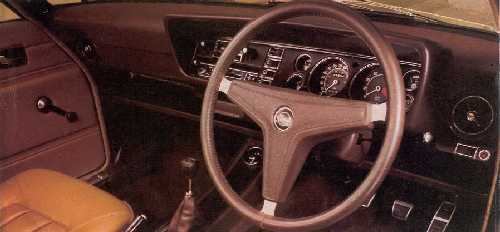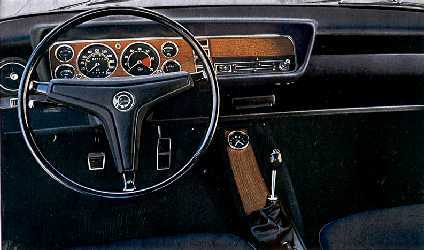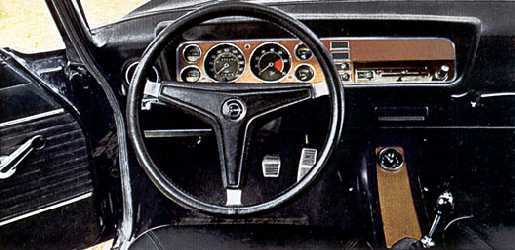|
|
|




1970 Ford Capri Mk 1 3000E dash (Picture: Ford UK)
Here are some samples of contemporary Capri Mk 1 tests and press reviews.
End 1972 the editors of "Autotest 1973" wrote, after tesing several
Capris:
The Capri
has recently undergone some thorough changes. Ford claims 150 changes. They
are not all visible, but some are: the changed range of available engines,
the seats, the steering wheel, the dashboard, the headlights and the rear
lights. In addition to that, the whole Capri range was simplified to 8 basic
models and an RS 2600 available at special order.
Concerning the Capri 1300 we keep the same objections as for the Cortina/Taunus
1300. For the last car you could justify its existence for economical reasons,
but who desires the sporty lines of the Capri buys an unbalanced combination,
which also is certainly not a bargain. The Fl 700,- (318 EURO) extra for the
1600 does not only give an engine with more power, but also servo-assisted
brakes and radial tyres. Taking into account also the rest-value when selling
the car, we think the extra money is well spent. The 1592 cc-engine in the
1600 is a smooth engine, giving power over a wide rpm range, gives acceptable
acceleration and a top speed of around 155 km/h. This is not shocking, but
sufficient for everyday use. The way in which the engine behaves expects to
give a long life-time of the engine.
Just like in other Fords, the gearbox is an excellent example of light and
exact gear changing, while in the Capri the clutch gives more feeling. Also
the servo-brakes gives excellent braking. Much better than in the 1300, which
is not equipped with such servo-brakes. The comfort in the Capri is good.
The seats have improved a lot. They're better shaped and give good support.
In corners, the Capri handles better than other 'big' Fords. It also handles
better than Capri's of previous years. Still, the performance is however not
completely balanced with the sporty looks. A car which needs to attract such
a wide group of different buyers is mostly a compromise. So is this car. It's
a compromise which does not really have sporty performance, but the suspension
is quite stiff. Also the engine indicates a compromise. The torque is available
at quite low revs, and its unwilling of high revs. The maximum power is already
available at 5000 rpm.
The space in the Capri is good for a small family. The backseat is more for
short rides when transporting adults. The Capri is a family coupe, more of
a 2+2. Small drivers will have some trouble with the not optimum visibility,
because the driving position is quite low. But, al in all: the Capri's have
improved significantly.
The Capri 1600 GT has a large amount of gauges, and looks more sporty on both
the inside and outside. Here the engine produces 88 HP @ 5700 rpm, but the
maximum torque is now available at 4000 rpm. In all gears there's clearly
more pulling power available than in the normal 1600, while the top speed
of the 1600 GT is 170 km/h. However, you don't get it all for free, you need
to 'work' in the GT to keep it at speed. There is a reasonably big price-gap
between the 1600 and the 1600 GT (more than Fl 1000,- (454 EURO)), making
the GT a fairly expensive car. Or is the 1600 relatively cheap?
In short: for what the GT offers more, you also need to pay more.
In the Capri
1600 GT-level, the engine delivers 88 hp @ 5700 rpm, max torque 12,7 mkg @
4000 rpm. The top speed is 168 km/h and acceleration from 0 - 100 km/h takes
12.5 sec. Of course is the GT equipped as might be expected in a GT, like
rev-counter, oil-pressure gauge, ampere-meter, while the GT as tested was
also equipped with an oil-temperature meter. In addition to that: console,
short gear-lever, foglights etc. Price of the 1600 GT: Fl 11.674,- (5297 EURO).
Also a 2300 GT is available. Equipped with a 2293 cc V 6, giving 108 DIN HP
@ 5100 rpm and a top speed of 180 km/h. Price: Fl 12.899,- (5853 EURO)
Both models can be equipped with additional extras like sports-steering wheel,
black hood, sports wheels etc. Their name is than GTR and they cost: 1600
GTR: Fl 11.924,- (5411 EURO), 2300 GTR: Fl 13.150,- (6967 EURO).
Finally, a GTR is available with a 2600 engine. To be more precise, 2551 cc,
125 DIN HP @ 5300 rpm and a top speed of 190 km/h. Equipped with wide 185/70
HR 13 tyres, this 2600 GTR accelerates from 0 -100 km/h in less than 8 sec.
Price: Fl 14.301,- (6490 EURO).

1971 Ford Capri Mk 1 GT Dash (Picture: Ford Germany)
Motor brief test No. 72 - Ford Capri 3000E 1972
When the Ford Capri was introduced in February 1969, it caused a near-sensation in the motor industry with a spread of engine options ranging from a modest 54 bhp 1300 unit right through to the 128 bhp 3-litre V6 (brought out in November 1969). The 3000 was the sovereign of the range with a virtually unbeatable combination of handling and performance at the price. However, our enjoyment of it was marred by several faults: The good handling was achieved at the expense of a poor ride; fan noise was excessive at high revs; low overall gearing made it fussy for high-speed cruising; second gear was too low; and the minor control layout was extremely muddled. On the second generation Capri 3000 most of the original faults have either been cured or improved, making the model truly outstanding value for money. Revised suspension settings have markedly improved the ride, arguably at the expense of handling at the absolute limit. A new fan has reduced noise and the more powerful engine is a lot more willing. Both the final drive and second gear ratios have been raised with consequent improvements in cruising, acceleration and driver appeal. Engine power output has been raised from 128 bhp (net) at 4750 rpm to 138 bhp (DIN) at 5000 rpm although torque has remained almost the same still at 3000 rpm. This has been achieved by a revised camshaft, inlet tracts and exhaust system and a rejetted carburettor. The effect is immediately noticeable-the engine revs willingly with a sporting exhaust note making the 5800 rpm redline a lot more realistic than before. The performance is now terrific. The revised gear ratios and increased power have paid handsome dividends. We lapped MIRA's banked circuit at 119.5 mph (the old 3 litre managed 110.5) which is just about as fast as you can go round the banking and achieve a meaningful result. Even at these speeds some speed is lost due to tyre scrub; a mean of two straight-line runs in opposite directions would certainly give over 120 mph. At 119.5 mph the engine is spinning at 5450 rpm which is well past its peak-it's a pity that overdrive is not available to make high speed cruising even faster and less fussy. Raising the overall second gear ratio from 7.11 to 6.02 means that now it's possible to do 66 mph in this gear, thus eliminating a gear change during the all-out 0-60 mph acceleration which is reduced by nearly a second-from 9.5 sec. to 8.6 sec. Reductions in the acceleration times become progressively greater as the speed increases until the 0-100 mph time is cut by 3 sec. to 26.5 sec. These figures show the substantial gains that can be made in top speed and acceleration using a relatively small increase in power with far better choice of gear ratios.

1971 Ford Capri Mk 1 GTR Dash (Picture: Ford Germany)
Road and Track, December 1971 - Ford Capri RS 2600 '72
The regular Capri 2600 GT's V-6 engine displaces 2551 cc and produces a healthy 125 DIN bhp on a 9.0:1 compression ratio with twin carburetors. For the RS, Ford bores the cylinders 2.2 mm more for 2637 cc, raises the compression ratio to 10:1, installs a more radical camshaft and freer exhaust system, and tops it off with a Kugelfischer mechanical fuel injection system . The result: 150 bhp DIN @ 5800 rpm. And performance in abundance. The whole car is lowered one inch by lower springs-it looks even squatter-and 13 x 6 aluminium or magnesium wheels by minilite with 185/70 radial tires. Bilstein gas-pressure shock absorbers are installed at the rear for better control of the live axle and the rear springs become single-leaf instead of multiple. The fuel-injection engine behaves like the highly tuned pushrod unit it is. It's a reluctant starter from cold, usually dies at least once after the first start, and doesn't really respond well from idling to "go" even when fully warmed up. If it had carburettors we'd call it overcarbureted! At idle (1100 rpm) it rumbles quietly-a sort of small-scale reproduction of the idle of a high-output U.S. V-8. Give it plenty of gas getting of from the rest, though, and it's underway with whatever amount of wheelspin the driver decrees. In 1st gear it's out of revs very quickly, but the other gears are plenty useful if one interprets the tachometer's red sector liberally, as we did. Third took us to 96 mph, and the 0-100 time of 20 sec shows that even in 4th there's still a good head of steam at 100 mph. That's the Capri RS 2600. Not everyman's car, but a bundle of fun if you've got a good place to use it and the nerve to extract its potential.
Autocar 30 October 1969 - Ford Capri 3000GT XLR 1969
Ford announced that there would be a 3-litre version of the Capri when this range of sports coupes was launched in January (4-cyl. models only -ed.), but only at the beginning of this month has the car become available. The engine and gearbox are taken from the Ford Zodiac without any significant modification, other than changes necessary to make the marriage. Power output of the 2994 cc vee-6 is 136 bhp(net) at 4750 rpm, with maximum torque of 181 lb ft at 3000 rpm. Installed in a car weighing only a little over a ton, this all promises exciting performance. From as low a speed as 15 mph in top gear the acceleration is impressive. The long nose, complete with power bulge, lifts a little as the car pulls away not with the kick you might at first expect, but a strong steady push. Up to 70 mph, the rising engine power just about matches the increase in drag. The 50 - 70 mph time of 7.7 sec is appreciably better than most of the 3-litre Capri's competitors. From a standing start it is possible to provoke wheelspin without axle tramp on a dry surface, 60 mph coming up in 10.3 sec, the standing quarter mile in 17.6 sec, and 100 in 34.9 sec. Apart from leaving rubber on the concrete all the way to 30 mph, these impressive acceleration times were achieved very easily, with no strain to the car. Like each of the more powerful Capris we have tried successively, we enjoyed the 3000 GT more than the basic model. As well as the obvious gains in performance, this car is much better on straight line stability and the steering has much more tangible response. The whole car, with the exception of the firm ride, is more refined also. At its price as a high performance GT it represents good value for money.

Once behind the wheel, you could study the manual:
.jpg)
I'd like to know what you think of my web site:
Send e-mail to: classiccar-webmaster
© M. Verberg - 2000 - 2005